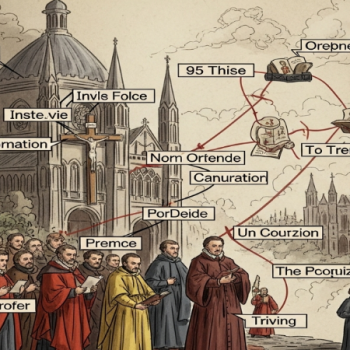
Perhaps the most universal of all human experiences is pain. No matter what stage of life one may find himself in, pain and suffering are ubiquitous.
The question is what if any meaning does pain have? If God is good and loving, why does He allow suffering? In the following discourse, I will explore these questions. First, we will see how the Bible addresses pain and look at two examples from the sufferings of Job and Saint Paul. Lastly, I will discuss suffering within the context of purification and redemption.
Why Is There Pain?
Before examining how Scripture addresses suffering and whether pain has a purpose, we must ask why God created a world with suffering and pain. The short answer is that He did not.
While it is true that suffering and death are natural to living things, human beings were initially preserved from death by God’s grace. It is only due to original sin that death entered the world (Genesis 2:17; Romans 5:12).
Nevertheless, pain is not evil per se; it can serve an essential function for all living things. For example, the fear of pain protects living things from danger, while the sensation of pain often indicates a medical problem. As such, it seems that Adam and Eve were capable of experiencing pain. That pain was increased due to original sin (Genesis 3:16).
Therefore, we may admit that suffering and dying are natural conditions. Only God’s grace preserved Adam and Eve from such sorrow, and that grace was lost as a result of original sin.
Having treated why there is pain and death in the world, let us see how Job and Saint Paul dealt with suffering and death.
Suffering in Scripture
Within the Bible, the embodiment of a good person who seems to suffer without reason is Job. Without delving too deeply into the Book of Job, it must suffice to say that Job was a wealthy man who was devoutly religious. According to the Scripture, God allows the devil to take away Job’s children and possessions. God also allows the devil to inflict physical maladies and illness’ upon Job. Despite this, Job remains devout and never losses his trust in God.
As the Book of Job closes, Job demands God tell him why he allowed him to suffer so much. The answer that Job receives does not explain away suffering. What God’s answer does amount to is that human beings cannot fathom God’s design and plan for the universe.
To be sure, this is not the most satisfying answer to Job’s question. But perhaps God’s response provides a clue as to how human beings are to respond to suffering; we are to trust God.
In the New Testament, we read of the suffering of Saint Paul. While not particularly specific, Paul writes that “A thorn was given me in the flesh, a messenger of Satan to harass me, to keep me from becoming conceited.” The word “thorn” is used metaphorically and may symbolize some chronic medical conditions.
Whereas the lesson gleaned from Job was one of trust in God, Paul’s suffering speaks to purification and atonement. Paul’s comment that his suffering was to keep him from arrogance suggests that he viewed suffering as a method to eliminate vice.
Indeed, pain and death play a pivotal role in understanding Catholic soteriology (doctrine of salvation). The suffering, death, and resurrection of Jesus provide the path to redemption. It is to this subject that I turn to next.
The Suffering Servant
At the heart of the Catholic concept of redemption and salvation is the rather remarkable assertion that God Himself became a human being, suffered, and died.
Accepting the existence of an omnipotent God, it seems that God could have redeemed mankind from original sin by simple Divine fiat. The fact that God descended into human suffering and took it upon Himself is telling. Rather than simply eliminating suffering, Jesus enters into suffering and thereby transforms it.
There are, I think, two aspects of suffering to consider. While both can be counterintuitive, they are significant to human development and atonement.
The first is to understand suffering as a form of character building. This seems to be what Saint Paul had in mind when he wrote, “We also glory in our sufferings, because we know that suffering produces perseverance; perseverance, character; and character, hope. And hope does not put us to shame, because God’s love has been poured out into our hearts through the Holy Spirit, who has been given to us.”
The second aspect of suffering plays a pivotal role in atonement and salvation. As was said above, suffering and death are consequences of sin. Logically, any process of atonement, therefore, must include some form of pain and death (Leviticus 17:11).
Without getting too far into Catholic soteriology, it must suffice to note that the death and resurrection of Christ provide human beings with the path to salvation. Still, we are allowed to cooperate with the saving act of Christ, and this is where human suffering and death are given meaning.
While human beings cannot save themselves, we can cooperate with the process of atonement by joining our suffering with the suffering of Christ on the Cross. The act of “offering up “one’s suffering allows one to unite ourselves with both the process of atonement, i.e., the suffering and crucifixion of Christ, as well as the fruit of that atonement, which is salvation through the resurrected Jesus.
To have compassion is to suffer along with someone, to “feel their pain.” When we suffer along with Christ, suffering becomes redemptive, and redemption gives pain and death meaning.
Conclusion
To be human is to suffer. However, if it is true that “All things work together for good to them that love God, to them who are the called according to his purpose” then our suffering and pain are not in vain.
As difficult and counterintuitive as it is, suffering is a gift. It is the opportunity to unite ourselves with our Savior, and to be united with God must be the goal of all Christians.












